seat adjustment BMW 325I 2002 Owners Manual
[x] Cancel search | Manufacturer: BMW, Model Year: 2002, Model line: 325I, Model: BMW 325I 2002Pages: 155, PDF Size: 2.17 MB
Page 4 of 155

Contents
© 2001 Bayerische Motoren Werke
Aktiengesellschaft
Munich, Germany
Reprinting, including excerpts, only with the
written consent of BMW AG, Munich.
Order No. 01 41 0 156 156
US English VIII/01
Printed in Germany
Printed on environmentally friendly paper
(bleached without chlorine, suitable for recycling).
Overview
Controls and features
Cockpit14
Instrument cluster15
Indicator and warning lamps17
Multifunction steering wheel
(MFL)21
Hazard warning triangle22
Refueling22
Fuel specifications23
Tire inflation pressures24
Opening and closing:
Keys28
Central locking system28
Opening and closing Ð via the
remote control29
Opening and closing Ð via the
door lock31
Opening and closing Ð from the
inside32
Tailgate33
Rear window34
Cargo area35
Alarm system35
Electric power windows37
Sliding/tilt sunroof38
Adjustments:
Correct sitting posture40
Seats40
Manual seat adjustment41
Power seat adjustment42
Lumbar support42
Head restraints43
Safety belts44
Seat and mirror memory45
Seat heating46
Steering wheel46
Mirrors47
Passenger safety systems:
Airbags48
Transporting children safely51Vehicle Memory, Key
Memory54
Driving:
Ignition lock55
Starting the engine55
Switching off the engine56
Parking brake57
Manual transmission57
Automatic transmission with
Steptronic58
Indicator/Headlamp flasher60
Washer/Wiper system/Rain
sensor61
Cruise control63
Everything under control:
Odometer65
Tachometer65
Energy control65
Fuel gauge66
Coolant temperature gauge66
Service Interval Display66
Check Control67
Clock67
Computer68
Technology for safety and
driving convenience:
Park Distance Control (PDC)70
Automatic Stability Control plus
Traction (ASC+T)71
Dynamic Stability Control
(DSC)73
Contents
Page 40 of 155

40n
Correct sitting posture SeatsFor relaxed and fatigue-free driving you
should select a sitting position that
reflects your personal requirements.
Correct posture combines with safety
belts and airbags to enhance occupant
safety in the event of an accident. To
ensure that the vehicle's safety systems
provide you with optimal protection, we
request that you direct your careful
attention to the following section.
For additional information on trans-
porting children refer to page 51. Sitting correctly with airbags
Always maintain an adequate
distance between yourself and the
airbags. Always hold the steering wheel
by the rim to keep any chance of injury
to hands or arms to an absolute
minimum should the airbag be
deployed. Never allow any objects,
individuals or animals to obstruct the
areas between passengers and airbags.
Never use the front airbag's cover as a
storage tray or support for objects of
any kind. Never allow front passengers
to rest their feet or legs on the airbag
cover.<
For airbag locations and additional
information on airbags refer to page 48.
Safe with safety belts
Never allow more than one person
to wear a single safety belt. Never
allow an infant or small child to ride in a
passenger's lap. Avoid twisting the belt
while routing it firmly across the hips
and shoulder, wear it as snugly against
your body as possible. Do not allow the
belt to rest against hard or fragile
objects. Do not route the belt across
your neck, or run it across sharp edges.
Be sure that the belt does not become
caught or jammed. Avoid wearing loose
or bulky clothing. You should remember
to retension the lap belt periodically by
pulling the shoulder strap to take up
any slack in the mechanism. In the
event of a frontal impact, a loose lap
belt could slide over your hips, leading
to abdominal injury. In addition, the
safety belt's restraint effectiveness is
reduced if the belt is worn loosely.
Expectant mothers should always wear
their safety belts, taking care to position
the lap belt against the lower hips,
where it will not exert pressure against
the abdominal area. <
For information on using safety belts,
refer to page 44.
When adjusting your seat, always
observe the following precautions
Never try to adjust your seat while
operating the vehicle. The seat
could respond with unexpected move-
ment, and the ensuing loss of vehicle
control could lead to an accident. Never
ride with the backrest reclined to an
extreme horizontal angle (important for
front passengers to remember). Keep
the backrest relatively upright to mini-
mize the risk of sliding under the safety
belt and sustaining injury in an acci-
dent.<
Seat adjustment>Manual seat adjustment, refer to
page 41
>Power seat adjustment, refer to
page 42
>Head restraint, refer to page 43
Page 41 of 155
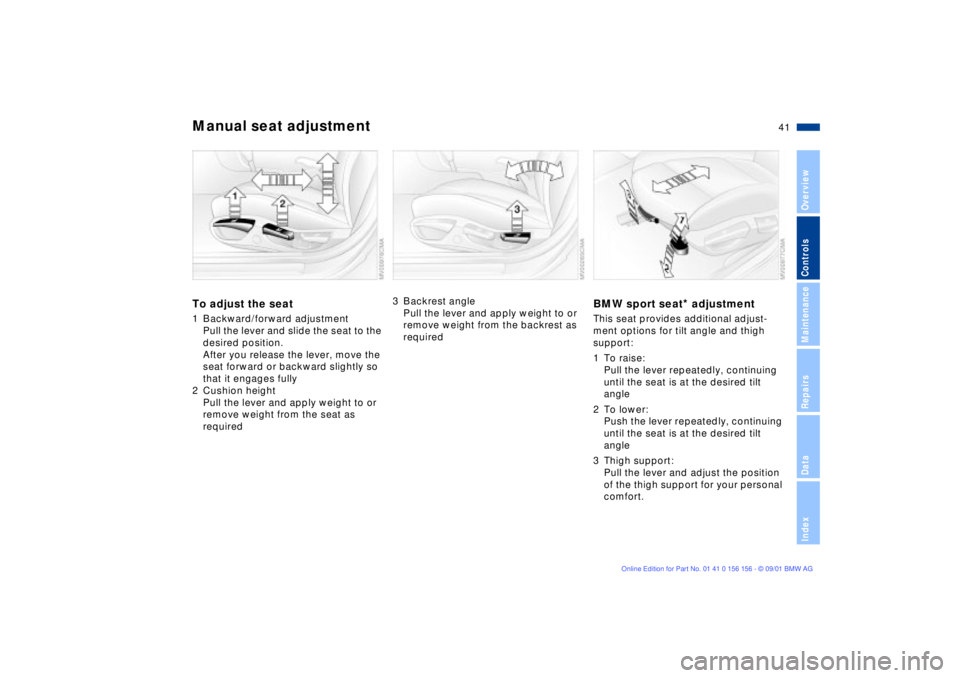
41n
OverviewControlsMaintenanceRepairsDataIndex
Manual seat adjustmentTo adjust the seat1 Backward/forward adjustment
Pull the lever and slide the seat to the
desired position.
After you release the lever, move the
seat forward or backward slightly so
that it engages fully
2 Cushion height
Pull the lever and apply weight to or
remove weight from the seat as
required
3 Backrest angle
Pull the lever and apply weight to or
remove weight from the backrest as
required
BMW sport seat
* adjustment
This seat provides additional adjust-
ment options for tilt angle and thigh
support:
1 To raise:
Pull the lever repeatedly, continuing
until the seat is at the desired tilt
angle
2 To lower:
Push the lever repeatedly, continuing
until the seat is at the desired tilt
angle
3 Thigh support:
Pull the lever and adjust the position
of the thigh support for your personal
comfort.
Page 42 of 155
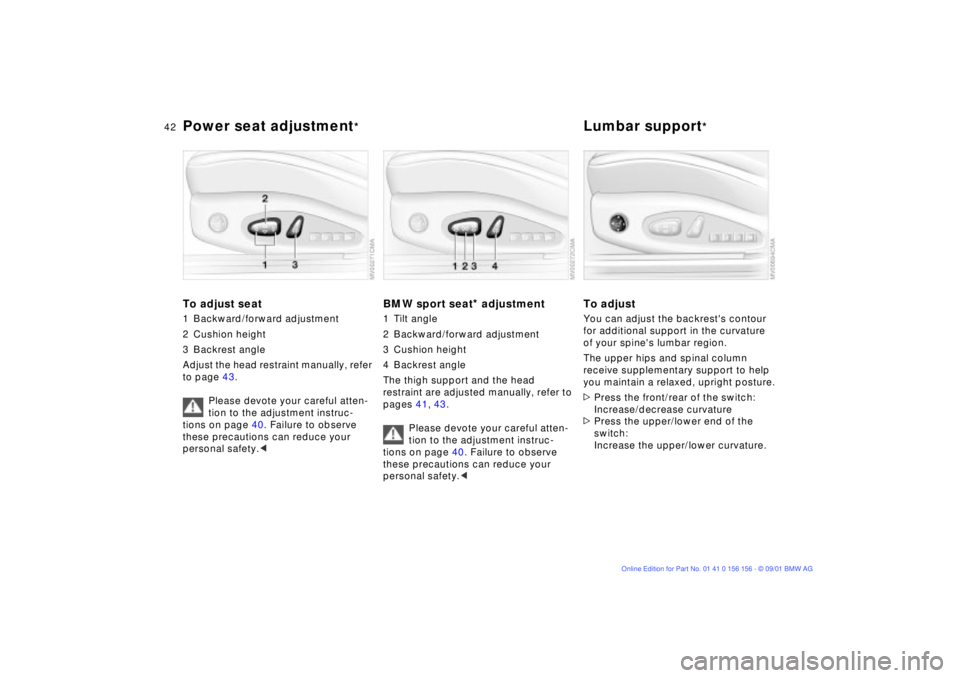
42n
Power seat adjustment
*
Lumbar support
*
To adjust seat1 Backward/forward adjustment
2 Cushion height
3 Backrest angle
Adjust the head restraint manually, refer
to page 43.
Please devote your careful atten-
tion to the adjustment instruc-
tions on page 40. Failure to observe
these precautions can reduce your
personal safety.<
BMW sport seat
* adjustment
1 Tilt angle
2 Backward/forward adjustment
3 Cushion height
4 Backrest angle
The thigh support and the head
restraint are adjusted manually, refer to
pages 41, 43.
Please devote your careful atten-
tion to the adjustment instruc-
tions on page 40. Failure to observe
these precautions can reduce your
personal safety.<
To adjustYou can adjust the backrest's contour
for additional support in the curvature
of your spine's lumbar region.
The upper hips and spinal column
receive supplementary support to help
you maintain a relaxed, upright posture.
>Press the front/rear of the switch:
Increase/decrease curvature
>Press the upper/lower end of the
switch:
Increase the upper/lower curvature.
Page 44 of 155
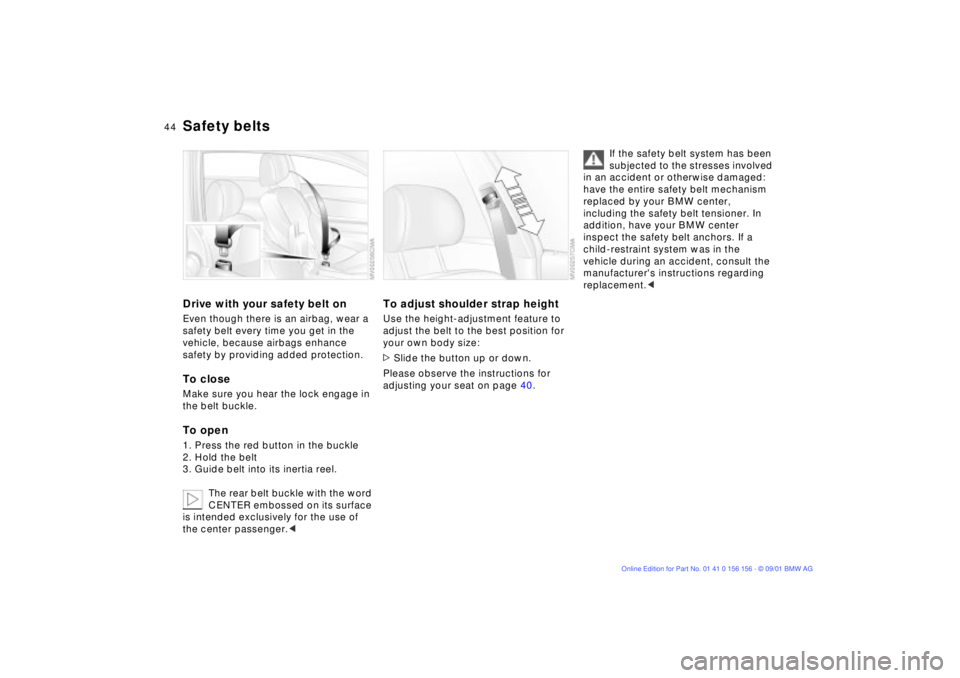
44n
Safety beltsDrive with your safety belt onEven though there is an airbag, wear a
safety belt every time you get in the
vehicle, because airbags enhance
safety by providing added protection.To closeMake sure you hear the lock engage in
the belt buckle.To open1. Press the red button in the buckle
2. Hold the belt
3. Guide belt into its inertia reel.
The rear belt buckle with the word
CENTER embossed on its surface
is intended exclusively for the use of
the center passenger.<
To adjust shoulder strap heightUse the height-adjustment feature to
adjust the belt to the best position for
your own body size:
>Slide the button up or down.
Please observe the instructions for
adjusting your seat on page 40.
If the safety belt system has been
subjected to the stresses involved
in an accident or otherwise damaged:
have the entire safety belt mechanism
replaced by your BMW center,
including the safety belt tensioner. In
addition, have your BMW center
inspect the safety belt anchors. If a
child-restraint system was in the
vehicle during an accident, consult the
manufacturer's instructions regarding
replacement.<
Page 45 of 155
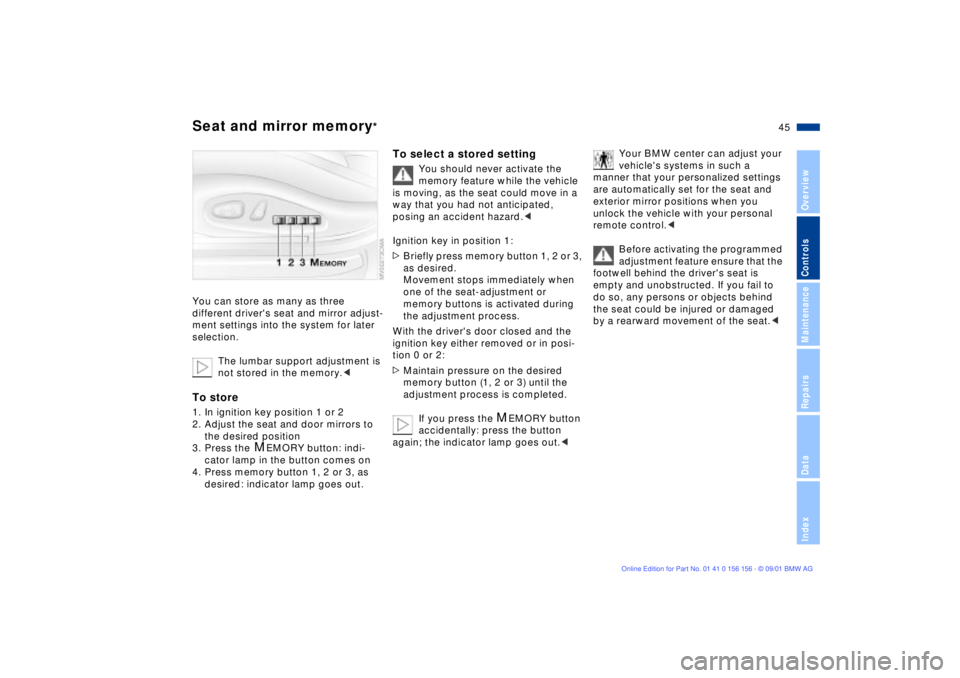
45n
OverviewControlsMaintenanceRepairsDataIndex
Seat and mirror memory
*
You can store as many as three
different driver's seat and mirror adjust-
ment settings into the system for later
selection.
The lumbar support adjustment is
not stored in the memory.
the desired position
3. Press the
M
EMORY button: indi-
cator lamp in the button comes on
4. Press memory button 1, 2 or 3, as
desired: indicator lamp goes out.
To select a stored setting
You should never activate the
memory feature while the vehicle
is moving, as the seat could move in a
way that you had not anticipated,
posing an accident hazard.<
Ignition key in position 1:
>Briefly press memory button 1, 2 or 3,
as desired.
Movement stops immediately when
one of the seat-adjustment or
memory buttons is activated during
the adjustment process.
With the driver's door closed and the
ignition key either removed or in posi-
tion 0 or 2:
>Maintain pressure on the desired
memory button (1, 2 or 3) until the
adjustment process is completed.
If you press the
M
EMORY button
accidentally: press the button
again; the indicator lamp goes out.<
Your BMW center can adjust your
vehicle's systems in such a
manner that your personalized settings
are automatically set for the seat and
exterior mirror positions when you
unlock the vehicle with your personal
remote control.<
Before activating the programmed
adjustment feature ensure that the
footwell behind the driver's seat is
empty and unobstructed. If you fail to
do so, any persons or objects behind
the seat could be injured or damaged
by a rearward movement of the seat.<
Page 46 of 155
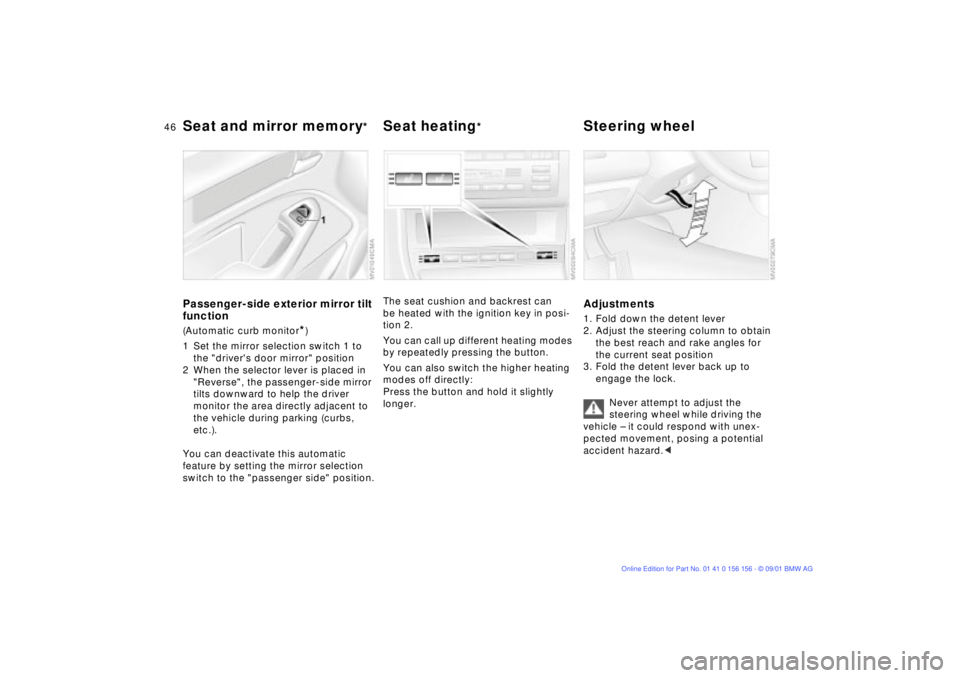
46n
Seat and mirror memory
*
Seat heating
*
Steering wheel
Passenger-side exterior mirror tilt
function(Automatic curb monitor
*)
1 Set the mirror selection switch 1 to
the "driver's door mirror" position
2 When the selector lever is placed in
"Reverse", the passenger-side mirror
tilts downward to help the driver
monitor the area directly adjacent to
the vehicle during parking (curbs,
etc.).
You can deactivate this automatic
feature by setting the mirror selection
switch to the "passenger side" position.
The seat cushion and backrest can
be heated with the ignition key in posi-
tion 2.
You can call up different heating modes
by repeatedly pressing the button.
You can also switch the higher heating
modes off directly:
Press the button and hold it slightly
longer.
Adjustments1. Fold down the detent lever
2. Adjust the steering column to obtain
the best reach and rake angles for
the current seat position
3. Fold the detent lever back up to
engage the lock.
Never attempt to adjust the
steering wheel while driving the
vehicle Ð it could respond with unex-
pected movement, posing a potential
accident hazard.<
Page 47 of 155
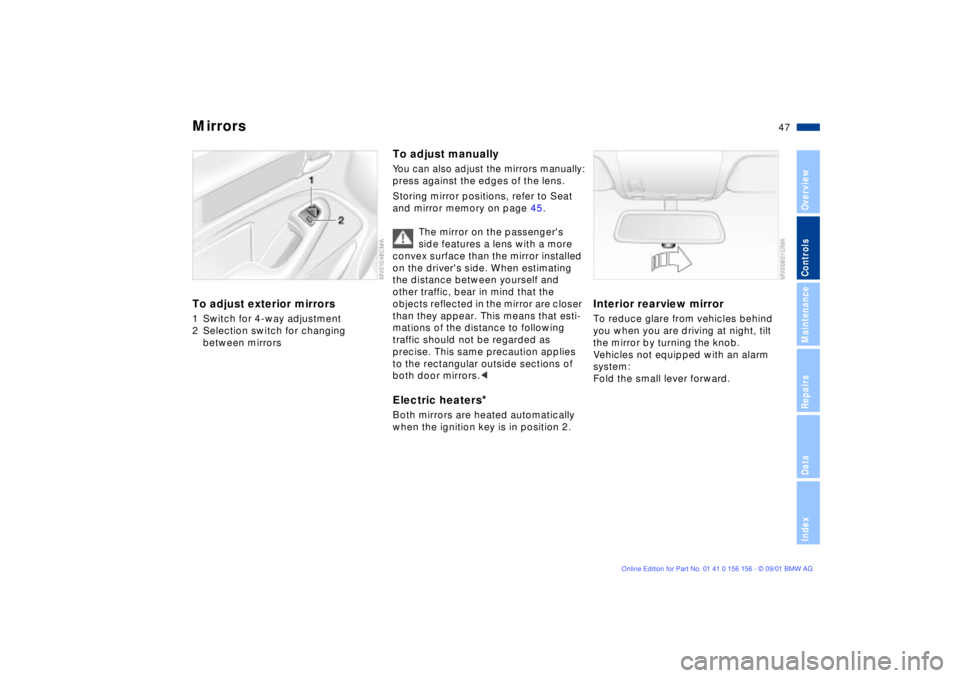
47n
OverviewControlsMaintenanceRepairsDataIndex
Mirrors To adjust exterior mirrors1 Switch for 4-way adjustment
2 Selection switch for changing
between mirrors
To adjust manuallyYou can also adjust the mirrors manually:press against the edges of the lens.
Storing mirror positions, refer to Seat
and mirror memory on page 45.
The mirror on the passenger's
side features a lens with a more
convex surface than the mirror installed
on the driver's side. When estimating
the distance between yourself and
other traffic, bear in mind that the
objects reflected in the mirror are closer
than they appear. This means that esti-
mations of the distance to following
traffic should not be regarded as
precise. This same precaution applies
to the rectangular outside sections of
both door mirrors.
Both mirrors are heated automatically
when the ignition key is in position 2.
Interior rearview mirror To reduce glare from vehicles behind
you when you are driving at night, tilt
the mirror by turning the knob.
Vehicles not equipped with an alarm
system:
Fold the small lever forward.
Page 54 of 155
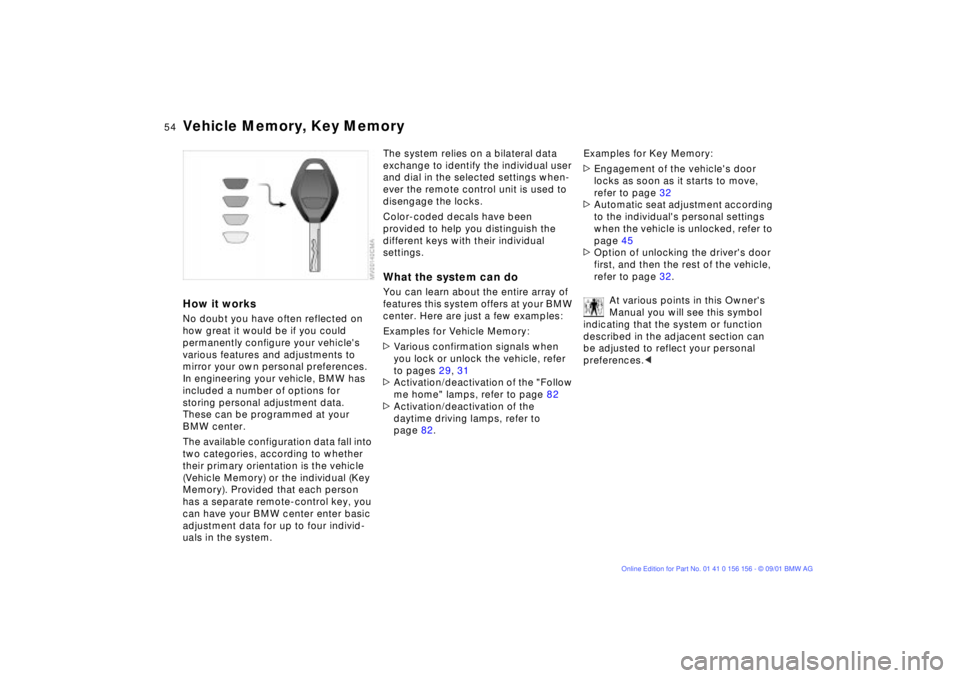
54n
Vehicle Memory, Key Memory How it worksNo doubt you have often reflected on
how great it would be if you could
permanently configure your vehicle's
various features and adjustments to
mirror your own personal preferences.
In engineering your vehicle, BMW has
included a number of options for
storing personal adjustment data.
These can be programmed at your
BMW center.
The available configuration data fall into
two categories, according to whether
their primary orientation is the vehicle
(Vehicle Memory) or the individual (Key
Memory). Provided that each person
has a separate remote-control key, you
can have your BMW center enter basic
adjustment data for up to four individ-
uals in the system.
The system relies on a bilateral data
exchange to identify the individual user
and dial in the selected settings when-
ever the remote control unit is used to
disengage the locks.
Color-coded decals have been
provided to help you distinguish the
different keys with their individual
settings.What the system can doYou can learn about the entire array of
features this system offers at your BMW
center. Here are just a few examples:
Examples for Vehicle Memory:
>Various confirmation signals when
you lock or unlock the vehicle, refer
to pages 29, 31
>Activation/deactivation of the "Follow
me home" lamps, refer to page 82
>Activation/deactivation of the
daytime driving lamps, refer to
page 82.Examples for Key Memory:
>Engagement of the vehicle's door
locks as soon as it starts to move,
refer to page 32
>Automatic seat adjustment according
to the individual's personal settings
when the vehicle is unlocked, refer to
page 45
>Option of unlocking the driver's door
first, and then the rest of the vehicle,
refer to page 32.
At various points in this Owner's
Manual you will see this symbol
indicating that the system or function
described in the adjacent section can
be adjusted to reflect your personal
preferences.<
Page 146 of 155
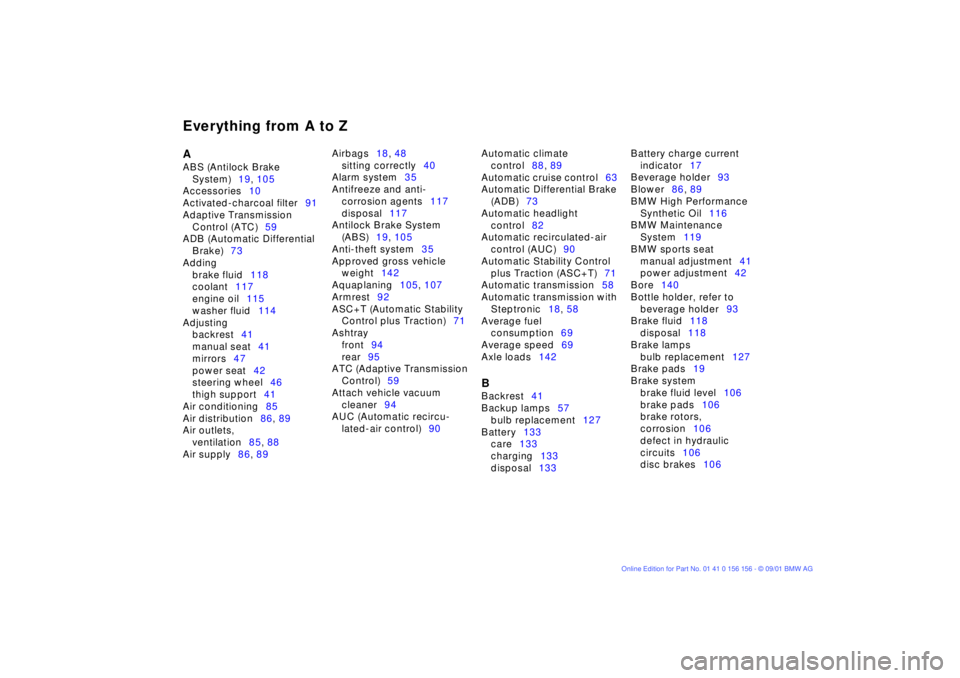
Everything from A to ZA
ABS (Antilock Brake
System)19, 105
Accessories10
Activated-charcoal filter91
Adaptive Transmission
Control (ATC)59
ADB (Automatic Differential
Brake)73
Adding
brake fluid118
coolant117
engine oil115
washer fluid114
Adjusting
backrest41
manual seat41
mirrors47
power seat42
steering wheel46
thigh support41
Air conditioning85
Air distribution86, 89
Air outlets,
ventilation85, 88
Air supply86, 89 Airbags18, 48
sitting correctly40
Alarm system35
Antifreeze and anti-
corrosion agents117
disposal117
Antilock Brake System
(ABS)19, 105
Anti-theft system35
Approved gross vehicle
weight142
Aquaplaning105, 107
Armrest92
ASC+T (Automatic Stability
Control plus Traction)71
Ashtray
front94
rear95
ATC (Adaptive Transmission
Control)59
Attach vehicle vacuum
cleaner94
AUC (Automatic recircu-
lated-air control)90 Automatic climate
control88, 89
Automatic cruise control63
Automatic Differential Brake
(ADB)73
Automatic headlight
control82
Automatic recirculated-air
control (AUC)90
Automatic Stability Control
plus Traction (ASC+T)71
Automatic transmission58
Automatic transmission with
Steptronic18, 58
Average fuel
consumption69
Average speed69
Axle loads142
B
Backrest41
Backup lamps57
bulb replacement127
Battery133
care133
charging133
disposal133 Battery charge current
indicator17
Beverage holder93
Blower86, 89
BMW High Performance
Synthetic Oil116
BMW Maintenance
System119
BMW sports seat
manual adjustment41
power adjustment42
Bore140
Bottle holder, refer to
beverage holder93
Brake fluid118
disposal118
Brake lamps
bulb replacement127
Brake pads19
Brake system
brake fluid level106
brake pads106
brake rotors,
corrosion106
defect in hydraulic
circuits106
disc brakes106
A-Z